 W
WThe Sun is the star at the center of the Solar System. It is a nearly perfect sphere of hot plasma, heated to incandescence by nuclear fusion reactions in its core, radiating the energy mainly as visible light and infrared radiation. It is by far the most important source of energy for life on Earth. Its diameter is about 1.39 million kilometres, or 109 times that of Earth. Its mass is about 330,000 times that of Earth, and accounts for about 99.86% of the total mass of the Solar System. Roughly three quarters of the Sun's mass consists of hydrogen (~73%); the rest is mostly helium (~25%), with much smaller quantities of heavier elements, including oxygen, carbon, neon, and iron.
 W
WSun sign astrology is a simplified system of Western astrology which considers only the position of the Sun at birth, which is said to be placed within one of the twelve zodiac signs. This sign is then called the sun sign or star sign of the person born in that twelfth-part of the year. Sun sign astrologers take this basic twelve-fold division and relate all the current movements of all the planets to each other, using traditional rules to divine meanings for each sign separately. Because the Moon has the fastest apparent movement of all the heavenly bodies, it is often used as the main indicator of daily trends for sun sign astrology forecasts.
 W
WSolar rotation varies with latitude. The Sun is not a solid body, but is composed of a gaseous plasma. Different latitudes rotate at different periods. The source of this differential rotation is an area of current research in solar astronomy. The rate of surface rotation is observed to be the fastest at the equator and to decrease as latitude increases. The solar rotation period is 24.47 days at the equator and almost 38 days at the poles. The average rotation is 28 days.
 W
WThe Sun Belt is a region of the United States generally considered to stretch across the Southeast and Southwest. Another rough definition of the region is the area south of the 36th parallel. Several climates can be found in the region — desert/semi-desert, Mediterranean (California), humid subtropical, subtropical highland and tropical.
 W
WBirkat Hachama refers to a rare Jewish blessing that is recited to the Creator, thanking Him for creating the sun. The blessing is recited when the sun completes its cycle every 28 years on a Tuesday at sundown. Jewish tradition says that when the Sun completes this cycle, it has returned to its position when the world was created. Because the blessing needs to be said when the sun is visible, the blessing is postponed to the following day, on Wednesday morning.
 W
WIn astrophysics, a bow shock occurs when the magnetosphere of an astrophysical object interacts with the nearby flowing ambient plasma such as the solar wind. For Earth and other magnetized planets, it is the boundary at which the speed of the stellar wind abruptly drops as a result of its approach to the magnetopause. For stars, this boundary is typically the edge of the astrosphere, where the stellar wind meets the interstellar medium.
 W
WSolar rotation varies with latitude. The Sun is not a solid body, but is composed of a gaseous plasma. Different latitudes rotate at different periods. The source of this differential rotation is an area of current research in solar astronomy. The rate of surface rotation is observed to be the fastest at the equator and to decrease as latitude increases. The solar rotation period is 24.47 days at the equator and almost 38 days at the poles. The average rotation is 28 days.
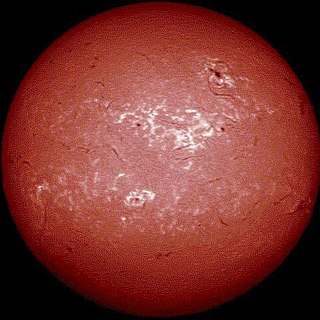 W
WThe chromosphere is the second of the three main layers in the Sun's atmosphere and is roughly 3,000 to 5,000 kilometers deep. Its rosy red color is only apparent during eclipses. The chromosphere sits just above the photosphere and below the solar transition region. The layer of the chromosphere atop the photosphere is homogeneous. A forest of hairy-appearing spicules rise from the homogeneous layer, some of which extend 10,000 km into the corona above.
 W
WCoronal holes are areas where the Sun's corona is colder, hence darker, and has lower-density plasma than average because there is lower energy and gas levels. Coronal holes are part of the Sun's corona and are constantly changing and reshaping because the corona is not uniform. The Sun contains magnetic fields that arch away from areas in the corona that are very thin due to the lower levels of energy and gas, which cause coronal holes to appear when they do not fall back. Thus, solar particles escape at a rate great enough to create a lower density and lower temperature in that area.
 W
WCoronal loops are huge loops of magnetic field beginning and ending on the Sun's visible surface (photosphere) projecting into the solar atmosphere (corona). Hot glowing ionized gas (plasma) trapped in the loops makes them visible. Coronal loops range widely in size up to several thousand kilometers long. They are transient features of the solar surface, forming and dissipating over periods of seconds to days. They form the basic structure of the lower corona and transition region of the Sun. These highly structured loops are a direct consequence of the twisted solar magnetic flux within the solar body. Coronal loops are associated with sunspots; the two "footpoints" where the loop passes through the sun's surface are often sunspots. This is because sunspots occur at regions of high magnetic field. The high magnetic field where the loop passes through the surface forms a barrier to convection currents, which bring hot plasma from the interior to the sun's surface, so the plasma in these high field regions is cooler than the rest of the sun's surface, appearing as a dark spot when viewed against the rest of the photosphere. The population of coronal loops varies with the 11 year solar cycle, which also influences the number of sunspots.
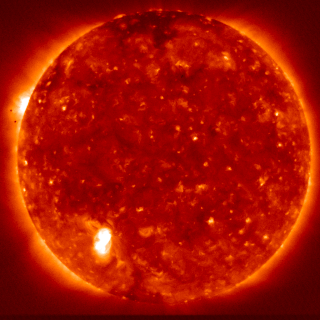 W
WIn astronomy and in astrophysics, for radiative losses of the solar corona, it is meant the energy flux radiated from the external atmosphere of the Sun, and, in particular, the processes of production of the radiation coming from the solar corona and transition region, where the plasma is optically-thin. On the contrary, in the chromosphere, where the temperature decreases from the photospheric value of 6000 K to the minimum of 4400 K, the optical depth is about 1, and the radiation is thermal.
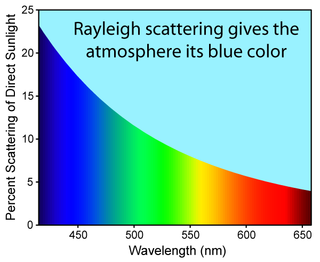 W
WDiffuse sky radiation is solar radiation reaching the Earth's surface after having been scattered from the direct solar beam by molecules or particulates in the atmosphere. Also called sky radiation, diffuse skylight, or just skylight, it is the determinative process for changing the colors of the sky. Approximately 23% of direct incident radiation of total sunlight is removed from the direct solar beam by scattering into the atmosphere; of this amount about two-thirds ultimately reaches the earth as photon diffused skylight radiation.
 W
WThe faint young Sun paradox or faint young Sun problem describes the apparent contradiction between observations of liquid water early in Earth's history and the astrophysical expectation that the Sun's output would be only 70 percent as intense during that epoch as it is during the modern epoch. The paradox is that: with the young sun's output at only 70 percent of its current output, the early earth would be expected to be completely frozen but the early earth seems to have had liquid water.
 W
WSunglasses or sun glasses are a form of protective eyewear designed primarily to prevent bright sunlight and high-energy visible light from damaging or discomforting the eyes. They can sometimes also function as a visual aid, as variously termed spectacles or glasses exist, featuring lenses that are colored, polarized or darkened. In the early 20th century, they were also known as sun cheaters.
 W
WSun glitter is a bright, sparkling light formed when sunlight reflects from water waves. The waves may be caused by natural movement of the water, or by the movement of birds or animals in the water. Even a ripple from a thrown rock will create a momentary glitter.
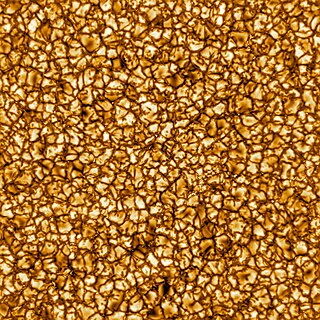 W
WGranules on the photosphere of the Sun are caused by convection currents of plasma within the Sun's convective zone. The grainy appearance of the solar photosphere is produced by the tops of these convective cells and is called granulation.
 W
WA heliometer is an instrument originally designed for measuring the variation of the sun's diameter at different seasons of the year, but applied now to the modern form of the instrument which is capable of much wider use.
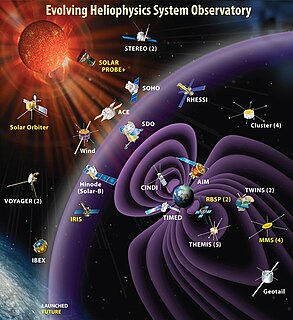 W
WHeliophysics is the science of the physical connections between the Sun and the solar system. NASA defines heliophysics as "(1) the comprehensive new term for the science of the Sun - Solar System Connection, (2) the exploration, discovery, and understanding of Earth's space environment, and (3) the system science that unites all of the linked phenomena in the region of the cosmos influenced by a star like our Sun. Heliophysics concentrates on the Sun, and its effects on Earth, the other planets of the solar system, and the changing conditions in space. Heliophysics is concerned with the magnetosphere, ionosphere, thermosphere, mesosphere, and upper atmosphere of the Earth and other planets. Heliophysics combines the science of the Sun, corona, heliosphere and geospace. Heliophysics encompasses cosmic rays and particle acceleration, space weather and radiation, dust and magnetic reconnection, nuclear energy generation and internal solar dynamics, solar activity and stellar magnetic fields, aeronomy and space plasmas, magnetic fields and global change, and the interactions of the solar system with our galaxy."
 W
WThe heliospheric current sheet is the surface in the Solar System where the polarity of the Sun's magnetic field changes from north to south. This field extends throughout the Sun's equatorial plane in the heliosphere. The shape of the current sheet results from the influence of the Sun's rotating magnetic field on the plasma in the interplanetary medium. A small electrical current flows within the sheet, about 10−10 A/m2. The thickness of the current sheet is about 10,000 km near the orbit of the Earth.
 W
WHelmet streamers are bright loop-like structures which develop over active regions on the Sun. They are closed magnetic loops which connect regions of opposite magnetic polarity. Electrons are captured in these loops, and cause them to glow very brightly. The solar wind elongates these loops to pointy tips. They far extend above most prominences into the corona, and can be readily observed during a solar eclipse. Helmet streamers are usually confined to the "streamer belt" in the mid latitudes, and their distribution follows the movement of active regions during the solar cycle. Small blobs of plasma, or "plasmoids" are sometimes released from the tips of helmet streamers, and this is one source of the slow component of the solar wind. In contrast, formations with open magnetic field lines are called coronal holes, and these are darker and are a source of the fast solar wind. Helmet streamers can also create coronal mass ejections if a large volume of plasma becomes disconnected near the tip of the streamer.
 W
WThe International Heliophysical Year is a UN-sponsored scientifically driven international program of scientific collaboration to understand external drivers of planetary environments and universal processes in solar-terrestrial-planetary-heliospheric physics. The IHY will focus on advancements in all aspects of the heliosphere and its interaction with the interstellar medium. This effort culminates in the "International Heliophysical Year" (IHY) in 2007-2008. The IHY concluded in February, 2009, but was largely continued via the International Space Weather Initiative (ISWI)
 W
WLāhainā Noon is a bi-annual tropical solar phenomenon when the Sun culminates at the zenith at solar noon, passing directly overhead. The term Lāhainā Noon was coined by the Bishop Museum in Hawai'i.
 W
WSunlight is a portion of the electromagnetic radiation given off by the Sun, in particular infrared, visible, and ultraviolet light. On Earth, sunlight is scattered and filtered through Earth's atmosphere, and is obvious as daylight when the Sun is above the horizon. When direct solar radiation is not blocked by clouds, it is experienced as sunshine, a combination of bright light and radiant heat. When blocked by clouds or reflected off other objects, sunlight is diffused. Sources indicate an "Average over the entire earth" of "164 Watts per square meter over a 24 hour day".
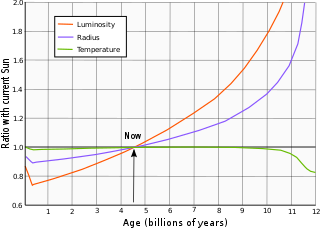 W
WThe solar luminosity, L☉, is a unit of radiant flux conventionally used by astronomers to measure the luminosity of stars, galaxies and other celestial objects in terms of the output of the Sun.
 W
WThe solar mass (M☉) is a standard unit of mass in astronomy, equal to approximately 2×1030 kg. It is often used to indicate the masses of other stars, as well as stellar clusters, nebulae, galaxies and black holes. It is approximately equal to the mass of the Sun. This equates to about two nonillion (short scale) or two quintillion (long scale) kilograms:M☉ = (1.98847±0.00007)×1030 kg
 W
WThe midnight sun is a natural phenomenon that occurs in the summer months in places north of the Arctic Circle or south of the Antarctic Circle, when the sun remains visible at the local midnight. When the midnight sun is seen in the Arctic, the sun appears to move from left to right, but in Antarctica the equivalent apparent motion is from right to left. This occurs at latitudes from 65°44' to 90° north or south, and this doesn't stop exactly at the Arctic Circle or the Antarctic Circle, due to refraction.
 W
WA nanoflare is a very small episodic heating event which happens in the corona, the external atmosphere of the Sun.
 W
WElectron neutrinos are produced in the Sun as a product of nuclear fusion. Solar neutrinos constitute by far the largest flux of neutrinos from natural sources observed on Earth, as compared with e.g. atmospheric neutrinos or the diffuse supernova neutrino background.
 W
WThe photosphere is a star's outer shell from which light is radiated.
 W
WThe position of the Sun in the sky is a function of both the time and the geographic location of observation on Earth's surface. As Earth orbits the Sun over the course of a year, the Sun appears to move with respect to the fixed stars on the celestial sphere, along a circular path called the ecliptic.
 W
WSolar power is the conversion of energy from sunlight into electricity, either directly using photovoltaics (PV), indirectly using concentrated solar power, or a combination. Concentrated solar power systems use lenses or mirrors and solar tracking systems to focus a large area of sunlight into a small beam. Photovoltaic cells convert light into an electric current using the photovoltaic effect.
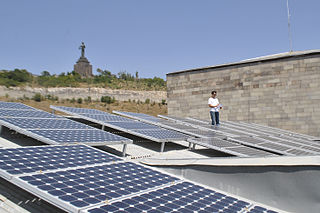 W
WSolar energy is widely available in Armenia due to its geographical position and is considered a developing industry.
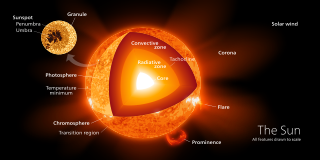 W
WA radiation zone, or radiative region is a layer of a star's interior where energy is primarily transported toward the exterior by means of radiative diffusion and thermal conduction, rather than by convection. Energy travels through the radiation zone in the form of electromagnetic radiation as photons.
 W
WThe solar constant (GSC) is a flux density measuring mean solar electromagnetic radiation per unit area. It is measured on a surface perpendicular to the rays, one astronomical unit (AU) from the Sun.
 W
WThe core of the Sun is considered to extend from the center to about 0.2 to 0.25 of solar radius. It is the hottest part of the Sun and of the Solar System. It has a density of 150 g/cm3 at the center, and a temperature of 15 million kelvins.
 W
WSolar rotation varies with latitude. The Sun is not a solid body, but is composed of a gaseous plasma. Different latitudes rotate at different periods. The source of this differential rotation is an area of current research in solar astronomy. The rate of surface rotation is observed to be the fastest at the equator and to decrease as latitude increases. The solar rotation period is 24.47 days at the equator and almost 38 days at the poles. The average rotation is 28 days.
 W
WA solar simulator is a device that provides illumination approximating natural sunlight. The purpose of the solar simulator is to provide a controllable indoor test facility under laboratory conditions, used for the testing of solar cells, sun screen, plastics, and other materials and devices.
 W
WSolar viewer are special eyewear designed for direct viewing of the Sun. Standard sunglasses are unable to filter out eye damaging radiation. Solar viewers are required for safe viewing of solar events such as eclipses. The recommended optical density of this eyewear is 5.
 W
WThe Solfilmen is a weather program, broadcast once a week as part of the news program Aktuellt) from the first Friday after Kiruna's first sunrise of the year to Midsummer. It shows the sunrise and sunset times for Lund, Stockholm, Lycksele, and Kiruna. A cartoon, it shows the Sun moving over the map of Sweden. The background music is an instrumental version of French folksong Le fiacre.
 W
WSpace climate is the long-term variation in solar activity within the heliosphere, including the solar wind, the Interplanetary magnetic field (IMF), and their effects in the near-Earth environment, including the magnetosphere of Earth and the ionosphere, the upper and lower atmosphere, climate, and other related systems. The scientific study of space climate is an interdisciplinary field of space physics, solar physics, heliophysics, and geophysics. It is thus conceptually related to terrestrial climatology, and its effects on the atmosphere of Earth are considered in climate science.
 W
WThe spectroheliograph is an instrument used in astronomy which captures a photographic image of the Sun at a single wavelength of light, a monochromatic image. The wavelength is usually chosen to coincide with a spectral wavelength of one of the chemical elements present in the Sun.
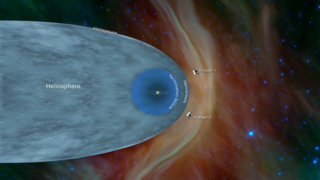 W
WThe heliosphere is the vast, bubble-like region of space that surrounds and is created by the Sun. In plasma physics terms, it is the cavity formed by the Sun in the surrounding interstellar medium. The "bubble" of the heliosphere is continuously "inflated" by plasma originating from the Sun, known as the solar wind. Outside the heliosphere, this solar plasma gives way to the interstellar plasma permeating the Milky Way. Radiation levels inside and outside the heliosphere differ; in particular, the galactic cosmic rays are less abundant inside the heliosphere, so that the planets inside are partly shielded from their impact. The word "heliosphere" is said to have been coined by Alexander J. Dessler, who is credited with first use of the word in scientific literature in 1967. The scientific study of the heliosphere is heliophysics, which includes space weather and space climate.
 W
WA corona is an aura of plasma that surrounds the Sun and other stars. The Sun's corona extends millions of kilometres into outer space and is most easily seen during a total solar eclipse, but it is also observable with a coronagraph. Spectroscopy measurements indicate strong ionization in the corona and a plasma temperature in excess of 1000000 kelvin, much hotter than the surface of the Sun.
 W
WA representation of the sun is used as a heraldic charge. The most usual form, often called sun in splendour or in his glory, consists of a round disc with the features of a human face surrounded by twelve or sixteen rays alternating wavy and straight. The alternating straight and wavy rays are often said to represent the light and heat of the sun respectively.
 W
WA Sun chart is a graph of the ecliptic of the Sun through the sky throughout the year at a particular latitude.
 W
WA sun dog or mock sun, formally called a parhelion in meteorology, is an atmospheric optical phenomenon that consists of a bright spot to one or both sides of the Sun. Two sun dogs often flank the Sun within a 22° halo.
 W
WSungazing is the act of looking directly into the sun during dawn and dusk. It is sometimes done as part of a spiritual or religious practice. The human eye is very sensitive, and prolonged exposure to direct sunlight can lead to solar retinopathy, pterygium, cataracts, and often blindness. Studies have shown that even when viewing a solar eclipse the eye can still be exposed to harmful levels of ultraviolet radiation.
 W
WSupra-arcade downflows (SADs) are sunward-traveling plasma voids that are sometimes observed in the Sun's outer atmosphere, or corona, during solar flares. In solar physics, an “arcade” refers to a bundle of coronal loops, and the prefix “supra” indicates that the downflows appear above flare arcades. They were first described in 1999 using the Soft X-ray Telescope (SXT) on board the Yohkoh satellite. SADs are byproducts of the magnetic reconnection process that drives solar flares, but their precise cause remains unknown.
 W
WThe tachocline is the transition region of stars of more than 0.3 solar masses, between the radiative interior and the differentially rotating outer convective zone. This causes the region to have a very large shear as the rotation rate changes very rapidly. The convective exterior rotates as a normal fluid with differential rotation with the poles rotating slowly and the equator rotating quickly. The radiative interior exhibits solid-body rotation, possibly due to a fossil field. The rotation rate through the interior is roughly equal to the rotation rate at mid-latitudes, i.e. in-between the rate at the slow poles and the fast equator. Recent results from helioseismology indicate that the tachocline is located at a radius of at most 0.70 times the solar radius, with a thickness of 0.04 times the solar radius. This would mean the area has a very large shear profile that is one way that large scale magnetic fields can be formed.
 W
WA solar telescope is a special purpose telescope used to observe the Sun. Solar telescopes usually detect light with wavelengths in, or not far outside, the visible spectrum. Obsolete names for Sun telescopes include heliograph and photoheliograph.
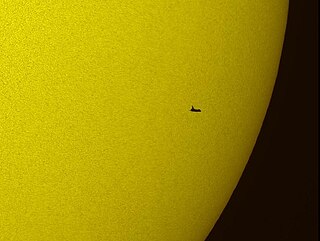 W
WIn astronomy, a solar transit is a movement of any object passing between the Sun and the Earth. This mainly includes the planets Mercury and Venus. A solar eclipse is also a solar transit of the Moon, but technically only if it does not cover the entire disc of the Sun, as "transit" counts only objects that are smaller than what they are passing in front of. Solar transit is only one of several types of astronomical transit.
 W
WThe solar transition region is a region of the Sun's atmosphere, between the chromosphere and corona. It is visible from space using telescopes that can sense ultraviolet. It is important because it is the site of several unrelated but important transitions in the physics of the solar atmosphere:Below, gravity tends to dominate the shape of most features, so that the Sun may often be described in terms of layers and horizontal features ; above, dynamic forces dominate the shape of most features, so that the transition region itself is not a well-defined layer at a particular altitude. Below, most of the helium is not fully ionized, so that it radiates energy very effectively; above, it becomes fully ionized. This has a profound effect on the equilibrium temperature. Below, the material is opaque to the particular colors associated with spectral lines, so that most spectral lines formed below the transition region are absorption lines in infrared, visible light, and near ultraviolet, while most lines formed at or above the transition region are emission lines in the far ultraviolet (FUV) and X-rays. This makes radiative transfer of energy within the transition region very complicated. Below, gas pressure and fluid dynamics usually dominate the motion and shape of structures; above, magnetic forces dominate the motion and shape of structures, giving rise to different simplifications of magnetohydrodynamics. The transition region itself is not well studied in part because of the computational cost, uniqueness, and complexity of Navier–Stokes combined with electrodynamics.